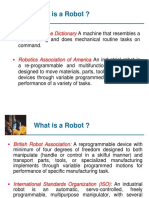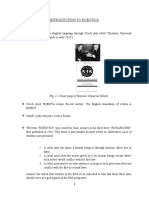0 ratings0% found this document useful (0 votes)
4 viewsIntroduction To Robotics Lecture1
Uploaded by
TahiraCopyright
© © All Rights Reserved
Available Formats
Download as PDF, TXT or read online on Scribd
0 ratings0% found this document useful (0 votes)
4 viewsIntroduction To Robotics Lecture1
Uploaded by
TahiraCopyright
© © All Rights Reserved
Available Formats
Download as PDF, TXT or read online on Scribd
You are on page 1/ 18
Introduction to Robotics
Emmanuel Ali(PhD)
October 10, 2024
Emmanuel Ali(PhD) 1st Semester October 10, 2024 1 / 18
Outline
1 Introduction
Emmanuel Ali(PhD) 1st Semester October 10, 2024 2 / 18
Introduction
What is a robot According to ISO 8373: A robot is defined as ”a
programmed actuated mechanism with a degree of autonomy to
perform locomotion, manipulation or positioning”.
Autonomy is the ability to perform intended tasks based on current
state and sensing, without human intervention
An industrial robot is defined to be an “automatically controlled,
reprogrammable, multipurpose manipulator, programmable in three or
more axes, which can be either fixed in place or fixed to a mobile
platform for use in automation applications in an industrial
environment.”
A mobile robot is a ”robot able to travel under its own control”
Service robot is a ”robot in personal use or professional use that
performs useful tasks for humans or equipment”
Emmanuel Ali(PhD) 1st Semester October 10, 2024 3 / 18
Introduction
Robotics is the science of designing, applying, and building robots for
all human and real life endeavors.
Robotics is an interdisciplinary subject that benefits from mechanical
engineering, electrical and electronic engineering, computer science,
biology, mathematics and physics.
Emmanuel Ali(PhD) 1st Semester October 10, 2024 4 / 18
History of artificial intelligence
Period Key Events
1921 Karel Capek coins the term robot in his play Rossum’s Universal Robots
(R.U.R). Robot comes from the Czech word robota, which means “servitude,
forced labor.”
1940 Sparko, the Westinghouse dog, uses both mechanical and electrical components.
It accompanied Electro a humanoid robot.
1950s The earliest robots were created by George C. Devol, an inventor from Louisville,
Kentucky. He invented and patented a reprogrammable manipulator called ”Uni-
mate” under ”Universal Automation.”
1958 Shakey was made at Stanford Research Institute International headed by Charles
Rosen. It contained a television camera, range finder, on-board logic, bump sen-
sors, camera control unit, and an antenna for a radio link. Shakey was controlled
by a computer in a different room.
Table 1: Some early events in robotics
Emmanuel Ali(PhD) 1st Semester October 10, 2024 5 / 18
Laws of Robotics
These are the Asimov’s laws of robotics:
Law One: A robot may not injure a human being or, through
inaction, allow a human being to come to harm.
Law Two: A robot must obey the orders given it by human beings
except where such orders would conflict with the First Law.
Law Three: A robot must protect its own existence as long as such
protection does not conflict with the First or Second Law.
Emmanuel Ali(PhD) 1st Semester October 10, 2024 6 / 18
Types of robots
There are two main divisions of a robot:
Robot manipulators: Fixed-base jointed robot arms which are now
quite common in manufacturing industry. This type of robot has
had a significant impact and is by far the most important
industrially and economically
Mobile robots: Vehicles capable of moving around their
environments to carry out tasks; tele-operation and
semi-autonomous
Emmanuel Ali(PhD) 1st Semester October 10, 2024 7 / 18
Parts of a manipulator
A robot manipulator, also known as a robot arm, is a complex mechanical
system typically composed of several parts that work together to enable the
robot to perform various tasks. The basic parts of a robot manipulator often
include:
Base: The base is the lowermost part of the robot arm, and it provides
stability and a point of attachment to the rest of the robot or its working
environment. It may have a rotating joint or a fixed base, depending on
the robot’s design.
Joints: Joints are the mechanical connections that allow different parts
of the robot to move relative to one another. The types of joints can
vary, including revolute (rotary) joints, prismatic (linear) joints,
spherical joints, cylindrical joints, and more, depending on the robot’s
design and intended range of motion.
Links: Links are the rigid segments that connect the joints. The links
determine the robot’s overall reach and are often referred to as the
robot’s ”arm.” Links can be of different lengths and materials, depending
on the robot’s application.
End-Effector: The end-effector, also known as the robot’s ”hand” or
”tool,” is the part of the robot that interacts with the environment or
performs tasks. The end-effector can take various forms depending on
the application, such as grippers, welding tools, cameras, or sensors.
Wrist: In many robot manipulators, the wrist is a specialized part near
the end of the arm. It typically contains additional joints that provide
flexibility to orient the end-effector precisely in three-dimensional space.
Emmanuel Ali(PhD) 1st Semester October 10, 2024 8 / 18
Parts of a manipulator
Actuators: Actuators are the components responsible for providing the
motion and force needed to operate the joints and move the robot’s
parts. Examples are electric motors, pneumatic or hydraulic cylinders.
Sensors: Sensors are used to provide feedback to the robot’s control
system, allowing it to perceive its environment and make decisions.
Common sensors include cameras, ultrasonic sensors, encoders, and
force/torque sensors.
Control System: The control system of the robot manipulator consists of
hardware and software that coordinate the robot’s movements and
actions. It processes sensor data and uses algorithms to determine the
appropriate joint angles and end-effector positions.
Teaching Pendant or Interface: Many industrial robots have a teaching
pendant or user interface that allows operators to program or control the
robot’s actions manually. This is useful for tasks like teaching the robot
specific positions and sequences.
Safety Features: Safety features, such as emergency stop buttons, safety
barriers, and sensors, are crucial to ensure the safe operation of the
robot, especially when working alongside humans.
Emmanuel Ali(PhD) 1st Semester October 10, 2024 9 / 18
Diagram of a robot manipulator
Figure 1: A labelled diagram of a robot manipulator
Emmanuel Ali(PhD) 1st Semester October 10, 2024 10 / 18
Manipulators Joints
Joints in robot manipulators are mechanical components that enable
movement and articulation in robotic arms. These joints allow the
robot to change the orientation and position of its end-effector within a
three-dimensional space. There are several common types of joints used
in robot manipulators, each providing specific types of motion and
determining its configuration. The choice of joint type can significantly
impact the robot’s range of motion, flexibility, and precision.
There are two main types of joint namely: revolute (rotary) or
prismatic (sliding).
Rotational (revolute) joint is in form of hinge limiting motion of
neighbouring segments to rotational motion around the hinge
Translational (prismatic) joint limits motion to translational
motion
Other joint types include helical, cylindrical, spherical, and planar.
Emmanuel Ali(PhD) 1st Semester October 10, 2024 11 / 18
Diagram of joints
(a) Prismatic (b) Prismatic (c) Revolute (d) Revolute
joint joint joint joint
Figure 2: The major types of joints.
Emmanuel Ali(PhD) 1st Semester October 10, 2024 12 / 18
Classification of Robot manipulators
Industrial robots can be classified according to sizes, shapes and
physical configuration:
Cartesian robot (rectangular robot, gantry robot)(TTT):
manipulator which has three prismatic joints, whose axes form a
Cartesian coordinate system
SCARA (selective compliant articulated robot for assembly)
robot(RRT): manipulator which has two parallel rotary joints to
provide compliance in a selected plane
Articulated (Anthropomorphic) robot (RRR): manipulator which
has three or more rotary joints
Cylindrical robot (RTT): manipulator which has at least one
rotary joint and at least one prismatic joint, whose axes form a
cylindrical coordinate system
Polar robot (spherical robot) (RRT): manipulator which has two
rotary joints and one prismatic joint, whose axes form a polar
coordinate system
Emmanuel Ali(PhD) 1st Semester October 10, 2024 13 / 18
Diagram of robot manipulator configuration
Figure 3: Different manipulator configuration
Emmanuel Ali(PhD) 1st Semester October 10, 2024 14 / 18
Classification of robot manipulators
Also, manipulators can be classified based on actuator type thereby
resulting in the control method, namely:
Servo: Numerous industrial manipulators utilize servo control
systems, ensuring that each joint actuator is operated with
closed-loop control, enabling precise positioning of the joint
anywhere within its operational range
Non servo: On the more affordable and less advanced side of the
market, you’ll find pick-and-place or on-off robots. These utilize
non-servo-controlled actuators that cease movement only upon
reaching a mechanical end-stop.
Emmanuel Ali(PhD) 1st Semester October 10, 2024 15 / 18
Mobile Robots
Mobile robots can be based on:
Locomotion - Climbing, Walking, Flying, Swimming, etc
Wheeled mobile robots - fixed, steerable, caster wheels
Legged mobile robots- Even/uneven terrains, Biped/multi-legged
Examples of mobile robots include
- Unmanned ground vehicles (UGVs)
- Unmanned air vehicles (UAVs)
- Unmanned underwater vehicles (UUVs)
- Humanoid robots
- Space robots; Mars rover
Emmanuel Ali(PhD) 1st Semester October 10, 2024 16 / 18
Application of robotics
Here are some of the applications of robotics:
Industrial
Underwater
Aerial
Space
Agriculture and forestry
Construction
Hazardous environments
Mining
Search and Rescue
Medical/Healthcare
Rehabilitation
Domestic
Education
Entertainment
Disabled/Elderly care
Emmanuel Ali(PhD) 1st Semester October 10, 2024 17 / 18
Ethics in robotics
Ethics are guiding principles to discern right and wrong.
Issues in robotics ethics include:
data responsibility and privacy,
moral agency and value alignment,
military applications,
autonomy,
robustness,
Coexistence with robots,
health application,
safety issues,
accountability,
trust, and
technology misuse
Emmanuel Ali(PhD) 1st Semester October 10, 2024 18 / 18
You might also like
- Unit 1 Fundamentals of Robots: Sukantho Sikder Electronics DepartmentNo ratings yetUnit 1 Fundamentals of Robots: Sukantho Sikder Electronics Department167 pages
- EC8074 Notes KSN - by WWW - EasyEngineering.net 1No ratings yetEC8074 Notes KSN - by WWW - EasyEngineering.net 1104 pages
- Mechanical Engineering Computer Integrated Manufacturing Systems Robotics NotesNo ratings yetMechanical Engineering Computer Integrated Manufacturing Systems Robotics Notes29 pages
- 02-Industrial Robots - Introduction - RevisedNo ratings yet02-Industrial Robots - Introduction - Revised30 pages
- Unit 8: Robotics: The Origins of RobotsNo ratings yetUnit 8: Robotics: The Origins of Robots29 pages
- Unit 2 Industrial Robotics: Learning ObjectivesNo ratings yetUnit 2 Industrial Robotics: Learning Objectives42 pages
- Unit 4: Introduction To Robot Fundamentals: MEL459: Mechatronics & Robotics100% (1)Unit 4: Introduction To Robot Fundamentals: MEL459: Mechatronics & Robotics70 pages
- Storyboard - Lesson 12 - Industrial Robot - V2No ratings yetStoryboard - Lesson 12 - Industrial Robot - V267 pages
- Me0506 Robotics Engg: Classification and Types of RobotNo ratings yetMe0506 Robotics Engg: Classification and Types of Robot65 pages
- Robotic Intro: by Jefferson Rey J. Arroyo, ECENo ratings yetRobotic Intro: by Jefferson Rey J. Arroyo, ECE39 pages
- RoboticsAndMechatronics IndustrialRobotics Part1 2021 CompressedNo ratings yetRoboticsAndMechatronics IndustrialRobotics Part1 2021 Compressed40 pages
- Industrial Robotics: The Heart of Modern ManufacturingNo ratings yetIndustrial Robotics: The Heart of Modern Manufacturing36 pages
- Unit1 - Fundamentals of Robotics - Industrial RoboticsNo ratings yetUnit1 - Fundamentals of Robotics - Industrial Robotics60 pages
- 2-Brief History, Types of Robots, Degrees of Freedom of Robots, Robot configurations-13-Jul-2020Material - I - 13-Jul-2020 - IntroductionNo ratings yet2-Brief History, Types of Robots, Degrees of Freedom of Robots, Robot configurations-13-Jul-2020Material - I - 13-Jul-2020 - Introduction62 pages
- Robotics - Chapter - One Fundamentals of RobotNo ratings yetRobotics - Chapter - One Fundamentals of Robot37 pages
- POR All Chapter Notes With Important QuestionsNo ratings yetPOR All Chapter Notes With Important Questions81 pages
- Unit - 1 - History, Robotic Configurations, Criteria For Defining A Robot and Robot CategoriesNo ratings yetUnit - 1 - History, Robotic Configurations, Criteria For Defining A Robot and Robot Categories16 pages
- Introduction To Robotics Ame553 11012020No ratings yetIntroduction To Robotics Ame553 11012020141 pages
- Mobile Robot: Unlocking the Visionary Potential of Mobile RobotsFrom EverandMobile Robot: Unlocking the Visionary Potential of Mobile RobotsNo ratings yet
- Project Camelot Aaron McCollum TranscriptNo ratings yetProject Camelot Aaron McCollum Transcript31 pages
- MS Undercroft Hollowcore Plank Placing Rev A WFNo ratings yetMS Undercroft Hollowcore Plank Placing Rev A WF12 pages
- Construction of Wire Rope: MR. Ajit Vilas DeshmukhNo ratings yetConstruction of Wire Rope: MR. Ajit Vilas Deshmukh8 pages
- Saarthi Education Jija Mata Colony, Near Paithan Gate A Bad. Cont: 8694947070 / 5050No ratings yetSaarthi Education Jija Mata Colony, Near Paithan Gate A Bad. Cont: 8694947070 / 50508 pages
- Sl. No. Institution Code Institution Name: Public Sector BanksNo ratings yetSl. No. Institution Code Institution Name: Public Sector Banks21 pages
- Template - Quarterly Accomplishment ReportNo ratings yetTemplate - Quarterly Accomplishment Report6 pages
- Unit 1 Fundamentals of Robots: Sukantho Sikder Electronics DepartmentUnit 1 Fundamentals of Robots: Sukantho Sikder Electronics Department
- Mechanical Engineering Computer Integrated Manufacturing Systems Robotics NotesMechanical Engineering Computer Integrated Manufacturing Systems Robotics Notes
- Unit 4: Introduction To Robot Fundamentals: MEL459: Mechatronics & RoboticsUnit 4: Introduction To Robot Fundamentals: MEL459: Mechatronics & Robotics
- Me0506 Robotics Engg: Classification and Types of RobotMe0506 Robotics Engg: Classification and Types of Robot
- RoboticsAndMechatronics IndustrialRobotics Part1 2021 CompressedRoboticsAndMechatronics IndustrialRobotics Part1 2021 Compressed
- Industrial Robotics: The Heart of Modern ManufacturingIndustrial Robotics: The Heart of Modern Manufacturing
- Unit1 - Fundamentals of Robotics - Industrial RoboticsUnit1 - Fundamentals of Robotics - Industrial Robotics
- 2-Brief History, Types of Robots, Degrees of Freedom of Robots, Robot configurations-13-Jul-2020Material - I - 13-Jul-2020 - Introduction2-Brief History, Types of Robots, Degrees of Freedom of Robots, Robot configurations-13-Jul-2020Material - I - 13-Jul-2020 - Introduction
- Unit - 1 - History, Robotic Configurations, Criteria For Defining A Robot and Robot CategoriesUnit - 1 - History, Robotic Configurations, Criteria For Defining A Robot and Robot Categories
- Mobile Robot: Unlocking the Visionary Potential of Mobile RobotsFrom EverandMobile Robot: Unlocking the Visionary Potential of Mobile Robots
- Construction of Wire Rope: MR. Ajit Vilas DeshmukhConstruction of Wire Rope: MR. Ajit Vilas Deshmukh
- Saarthi Education Jija Mata Colony, Near Paithan Gate A Bad. Cont: 8694947070 / 5050Saarthi Education Jija Mata Colony, Near Paithan Gate A Bad. Cont: 8694947070 / 5050
- Sl. No. Institution Code Institution Name: Public Sector BanksSl. No. Institution Code Institution Name: Public Sector Banks

























































































